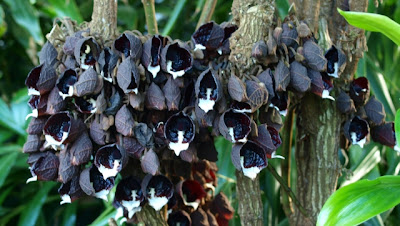Mushroom flowers in the glasshouse
Close up you can see the velvety texture of the mushroom hood, and the cute white markings underneath it (this picture is a little dark but if you squint and think positive thoughts you'll get the idea).
The mushroom mimicry of this species is exquisite. Even when magnified, the surface of the pretend mushroom looks like the real thing. And there is the lovely white painted lip to the flower giving the impression the mushroom is rising from a lovely white flat surface.
When the gnats try to lay eggs on the 'mushroom cap' they slide down its surface (which presumably isn't like the real thing) to get temporarily trapped underneath where they pick up, or deliver, pollen. You find this kind of pollination trickery is various plant families. The other great example is the orchid Dracula vampira which mimics a gilled bracket fungus.
Aristolochia arborea was described by Jean Jules Linden in 1858, from a specimen collected in Mexico. 'arborea' is a good species name given that most of the 300 or so species of Aristolochia climb and creep, while this one is a small tree growing up to 6 metres tall.
Quite a few Aristolochia species are given the common name Dutchman's Pipe, and their flowers can be oddly pipe-like. Others are shaped like great big dinner-plates and emit the most unpleasant of odours. In this case the cup-shaped flowers are all clustered at the base of the plant, like roosting bats. Easy to miss as you walk past this plant in Kew's Princess of Wales Conservatory.
Out of flower it looks like pretty much any tropical plant. The leaves alternate from one side to the other in two ranks a long drooping branch.
In flower though, it's like nothing else you are likely to see and with one of the more unusual pollination mechanisms. In tropical America, where Artistolochia arborea and its obliging mushroom gnats hang out, this one-sided relationship works well for the dominant life form on Earth, the plant.




Comments